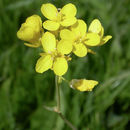Brief Summary
provided by EOL authors
Brassica rapa, field mustard, is an herbaceous annual or biennial species in the Brassicaceae (the cabbage or mustard family) from which various interrelated vegetable varieties have been developed, including turnips, bok choi, pak choi, tat soi (which are sometimes referred to as Chinese cabbages, or Chinese white- or Chinese flat cabbages, or celery mustard), pak choi sum (Chinese flowering cabbage), and napa cabbage (also called celery cabbage or pe tsai), among others. The species is thought to have originated in Europe, with many varieties developed in Asia, but its numerous varieties are now widely cultivated commercially and in home gardens in temperate and north temperate regions throughout the world. Some varieties have become naturalized and are considered weeds in regions of China and North America. B. rapa, formerly known as B. campestris, shows considerable variation in growth form and characteristics across the many cultivars, this species has, in general, a flat or globose root (in the case of turnips) without an elongated crown (as found in the rutabagas and kohlrabi, which are derived from B. olearacea), with stems that grow typically grow 30 to 120 cm (11.75 to 47.25 in), although in some cultivars up to 190 cm (75 in) tall. The leaves are large, soft, smooth or soft-hairy leaves, up to 50 cm (20 in) long, pinnatifid (deeply lobed) or lyrate (deeply lobed, but with an enlarged terminal lobe and smaller lateral lobes), which clasp the stem and may form a more or less dense head. The yellow, four-parted and cross-shaped flowers are small, usually less than 2 cm (0.75 in) long, and produce siliques—capsular fruit that dehisces (splits open) when mature—that may be up to 6 cm (2.5 in) long. With a long history of cultivation and diversification into many varieties with numerous and overlapping common names, it can be difficult to ascertain and classify the relationships among species and varieties (or subspecies). Varieties of B. rapa are generally placed into 4 major categories: 1) var. chinensis, which includes pak choi, bok choi, and tat soi, cultivars that originated in southeast Asia and have long been cultivated in China and Japan, where they are also widely naturalized. These form compact clusters of stems that are not as densely packed as in cabbage heads. The whole young plants are used for their leafy greens and fleshy green or white stems, either salted and fermented into a pickle known as pak choi can, or cooked in soups, stir-fries, and noodle dishes. 2) var. parachinensis, Chinese flowering cabbage (sometimes called Chinese broccoli, although that name generally refers to the related B. olearacea var. alboglabra), which has elongated fleshy stems and flowering shoots that do not form into tight clusters or heads. The flowering stems, along with their leaves and buds, are pickled or prepared as a cooked vegetable in numerous Asian dishes. 3) var. pekinensis, napa or celery cabbage (sometimes known as Peking cabbage or pe tsai), which may either have a dense head of flat-stemmed leaves, or may form simply a loose cluster of fleshy stemmed leaves. These varieties have a long history of cultivation in China, Japan, and Korea, where they are used in salads, soups, and as a cooked vegetable. This variety is commonly used to make the traditional Korean fermented cabbage dish, kimchee. 4) var. rapa, turnips, which have a fleshy, globe-shaped root. Described in Roman accounts dating to 400 B.C., they are one of the oldest cultivated root crops, and are still widely used in Europe, prepared raw or cooked in soups, stews, and sautés. The young leaves are also used as cooked greens. (Bailey et al. 1976, Flora of China 2012, Hedrick 1919, van Wyk 2005.)

